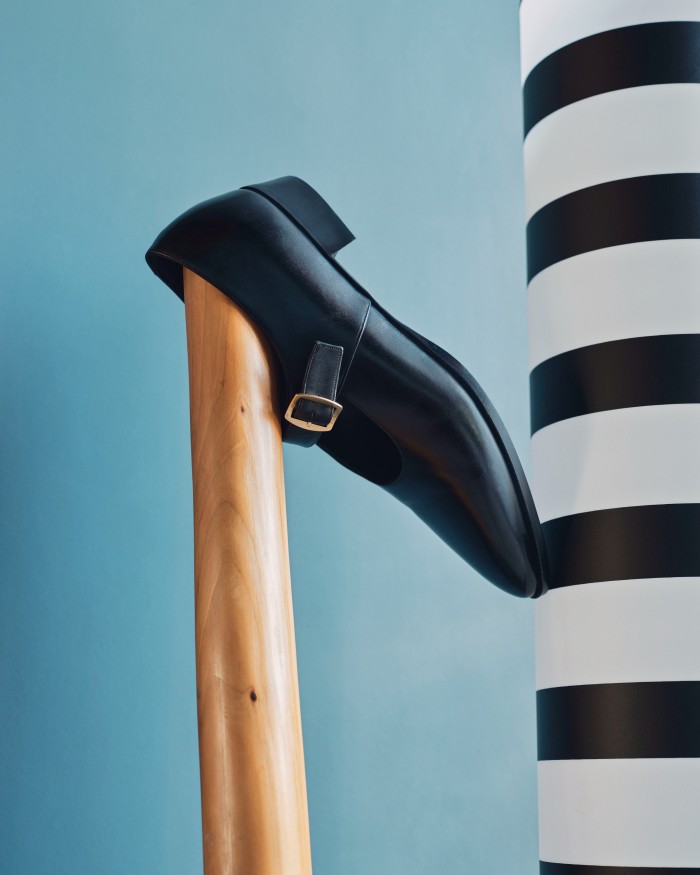How the Mary Jane went major

Simply sign up to the Style myFT Digest -- delivered directly to your inbox.
Mélanie Masarin vividly remembers buying her first pair of Mary Janes. The founder and CEO of non-alcoholic apéritif brand Ghia was seven or eight years old when her mother took her to a Repetto store in her hometown of Lyon and bought her a hand-stitched pair in silver leather, bridged at the insteps by elastics. The trip – and the shoes – became an anticipated back-to-school tradition. “I loved them so much, I wore them until both sides opened up,” Masarin says.
By many accounts, Mary Janes took their name from the sister figure in RF Outcault’s Buster Brown comics, first published in 1902. They were a fixture in the wardrobes of young boys and girls (see Shirley Temple and, later, a young John F Kennedy Jr). They were also adopted by flappers and women in Mao’s China, punk rockers, goths, a Mary Quant-clad Twiggy, Japan’s Lolita subculture and ’90s grunge artists such as Courtney Love.

“For many years these were quiet bestsellers,” says Cassie Smart, head of womenswear at Matches. Thanks to brands such as Miu Miu, The Row and Le Monde Beryl, however, the style has transcended its schoolgirl roots to become a hit shoe, with Matches reporting triple-digit growth for Mary Janes last year.
Erica Wright, founder of luxury fashion sourcing app Sourcewhere, says Mary Janes are currently one of the platform’s most-wanted shoes. She points to the Alaïa fishnet flats becoming “the most-requested item on the app”; first released in 2021, they have since been reissued in several iterations as a new staple of the brand; the latest versions come in studded suede and gold mesh. Other brands benefiting from the renaissance are Maison Margiela, which has released a Mary Jane version of its tabis, and Prada, whose 1998 grey Mary Janes are a “vintage style to watch for 2024”, adds Wright.
In the SS24 collections, they were paired with minidresses and long coats at Bally and Sandy Liang, sheer dresses at Christopher Esber and Collina Strada, knee-length shorts at Loewe and knitted hot pants at Versace. For Chanel’s latest Métiers d’Art collection, shown in Manchester in December, designer Virginie Viard teamed almost all 72 looks with a version of the style: flats and heels, many embellished with pearls or bows.

The Mary Jane has been a linchpin of Le Monde Beryl, the London-based brand launched by Lily Atherton Hanbury and Katya Shyfrin in 2016. Both Hanbury and Shyfrin found that the slippers weren’t just comfortable; they made sense as wardrobe staples amid work, kids and commutes. “I always laughed at the 10 pairs of shoes under [Hanbury’s] desk at the office, including a pair of trainers and a pair of heels,” says Shyfrin. “You couldn’t find that one perfect pair that carried you from day to night comfortably while looking chic.”
Le Monde Beryl’s first shoe was a take on the Venetian slipper, which it lined with leather to give it the fit and durability of a custom-made men’s shoe. It took the same approach with its Mary Janes, which it launched in 2020, and which are also sourced, made and finished by hand in Italy. As a result, the almond-toed shoes have a more structured, polished feel than the traditional soft slipper.
Having developed its Mary Janes “in a vacuum”, Hanbury and Shyfrin have been surprised by the shoe’s popularity. In the past year, the brand has tripled its turnover, with its global network growing from 21 wholesale partners for its SS23 collection to 102 retailers a year later. Though the brand has yet to make the shoes in men’s sizes, its founders have also spotted men wearing them – a reminder of the style’s unisex roots. “We knew our customers would love them so we bought into every colourway,” says Smart, predicting that the mesh and ponyhair styles will gain ground in 2024.

The vogue for Mary Janes has risen in tandem with a collective desire for comfort, not to mention a maelstrom of ultra-feminine aesthetics such as coquettecore, secretary chic and balletcore. Viral trends such as the “wrong shoe theory” – encouraging social media users to give outfits new life by pairing them with an off-kilter shoe choice – have also fed the appetite.
Masarin’s own growing collection includes a red embellished pair by Alaïa (she pre-ordered them immediately after being tipped off by a salesperson in Paris), ecru Chloé button-strap flats and several pairs by American DTC darling Rothy’s. Six was her estimate before she remembered the several pairs stashed at her parent’s place in France, as well as a gold pair from Miu Miu. Her most-worn are a denim pair by Chloé.
If the shoe’s history is anything to go by, the style should stick around for a good deal longer. “We have a customer who doubles up on the shoes, so she has six pairs in London and six of the exact same shoes in her country house,” says Shyfrin. “We all wear our version of a uniform and that’s when the concept is really brought to life.”
Special thanks to Yana Bourne

Comments